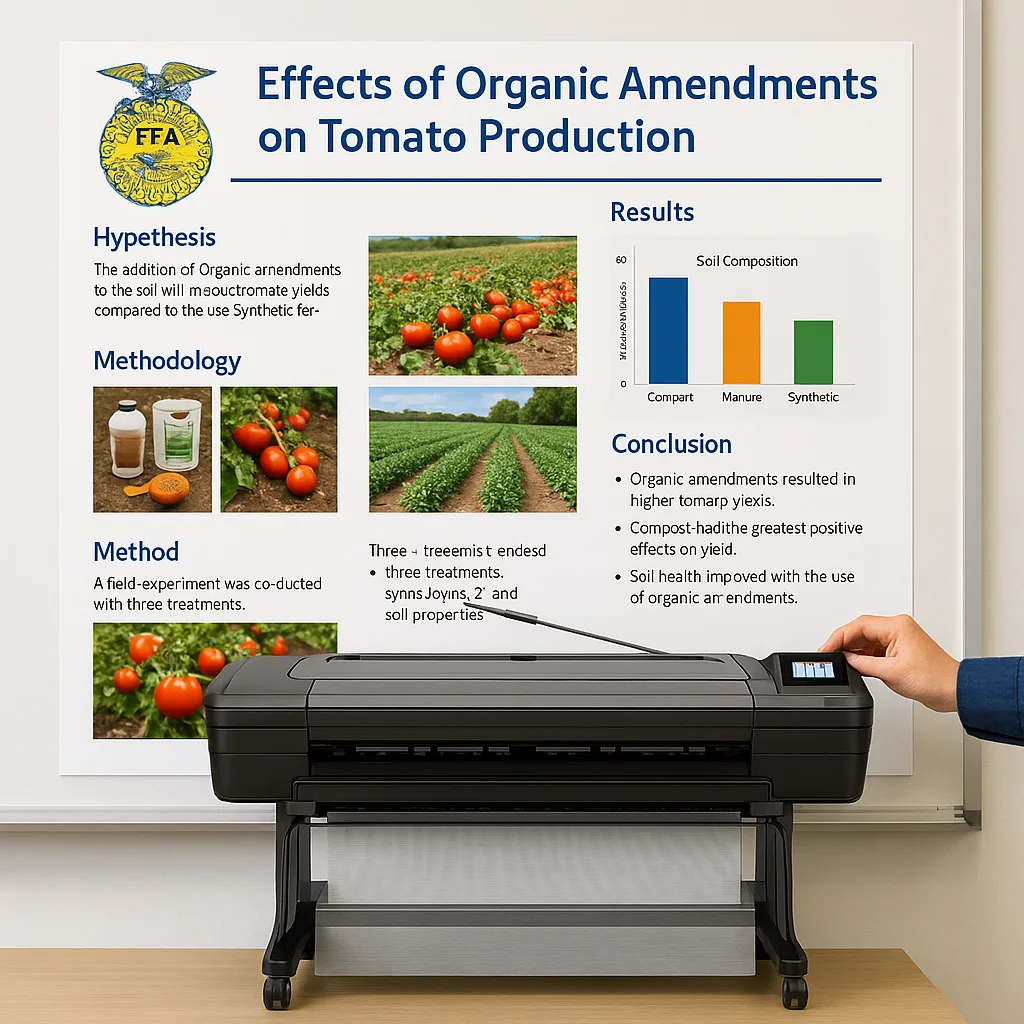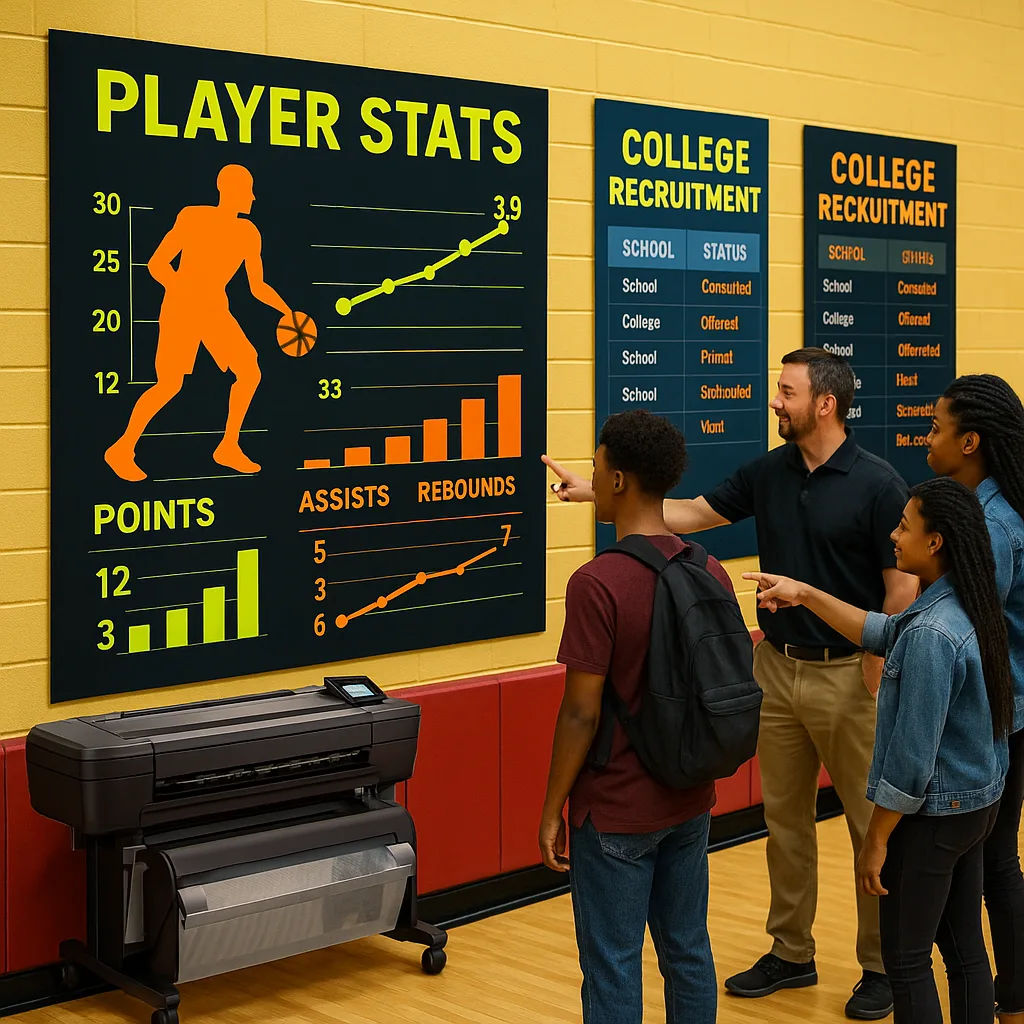
Poster Machines for Agricultural Science Fair Success
Agricultural science fairs represent critical moments where young researchers showcase months of careful experimentation and observation. Yet even groundbreaking research can fall flat without professional visual presentation. Modern poster machines for agricultural science empower FFA and 4-H students to create displays that match their scientific rigor.
From State Fair to STEM Fair: The Evolution of Agricultural Displays
Traditional tri-fold boards have given way to sophisticated research presentations in agricultural competitions. Subsequently, students now compete alongside university researchers at national symposiums. This shift demands professional-quality visual materials that communicate complex data effectively.
Furthermore, agricultural science encompasses diverse research areas—from soil chemistry to precision agriculture technology. Each discipline requires specialized visualization techniques. Therefore, having access to versatile printing equipment becomes essential for competitive programs.
Additionally, judges increasingly expect publication-quality graphics that mirror scientific journal standards. Students who present research on weathered cardboard immediately disadvantage themselves. Professional printing transforms student work into credible scientific communication.

Why Professional Printing Matters in Agricultural Competitions
Research from the National FFA Organization indicates that visual presentation accounts for 35% of total judging scores at state-level competitions. Moreover, students with professional displays report increased confidence during oral presentations. Quality visuals create lasting impressions that extend beyond competition day.
Understanding Scientific Poster Design Principles
Scientific posters follow established conventions that differ significantly from general educational displays. Consequently, agricultural science students must master these specialized design principles to compete effectively.
Visual Hierarchy Fundamentals
Effective research posters guide viewers through findings logically. Therefore, establish clear sections: Abstract, Introduction, Methods, Results, Discussion, and Conclusions. Each section requires appropriate spacing and consistent formatting.
Additionally, implement the “billboard test”—key findings should be readable from 6 feet away. This necessitates minimum 24-point body text and 72-point titles. However, avoid overwhelming viewers with dense text blocks.
Data Visualization Excellence
Agricultural research generates diverse data types requiring specialized visualization. For instance, soil composition demands different graphics than crop yield comparisons. Select chart types that enhance understanding rather than complicate interpretation.
Furthermore, maintain consistent color schemes throughout all graphics. Agricultural sciences traditionally use earth tones combined with vibrant accent colors for data highlights. Nevertheless, ensure sufficient contrast for accessibility.
Professional Typography Standards
Scientific posters demand readable, professional fonts. Sans-serif options like Arial or Calibri work well for body text. Meanwhile, slightly bolder fonts can emphasize section headers without appearing unprofessional.
Moreover, maintain consistent font sizes across similar elements. Captions should uniformly use 18-20 point text. Subsequently, viewers can navigate content predictably.
Typical Judging Weight Distribution
Breaking Down Competition Judging Criteria
Research Quality
35% of Score
Hypothesis clarity, methodology rigor, data collection protocols, statistical analysis, and conclusion validity form the foundation of scoring.Visual Communication
35% of Score
Layout organization, graphic quality, data visualization effectiveness, and poster readability significantly impact competitive success.Oral Presentation
30% of Score
Student knowledge, presentation skills, question handling, and professional demeanor complete the evaluation process.Understanding these criteria helps students allocate preparation time effectively. Visual presentation directly influences two-thirds of total scoring. Therefore, investing in professional printing equipment yields measurable competitive advantages.
Essential Poster Machines for Agricultural Science Programs
Selecting appropriate printing equipment requires understanding program needs and competition requirements. Agricultural science programs benefit from specific features that support diverse research presentations.
The Education Studio 36 Poster Maker offers ideal specifications for most FFA chapters. Its 36-inch width accommodates standard scientific poster dimensions. Additionally, water-resistant inks ensure displays survive outdoor demonstrations and humid fair environments.
Furthermore, programs presenting at multiple venues need portable yet durable materials. The Satin Photo Paper provides professional appearance without lamination requirements. This saves time during competition season while maintaining impressive visual quality.
For comprehensive program support, consider the Education Studio 36″ Duplicator Poster Maker Package A+. This complete solution includes everything needed for year-round poster production. Moreover, the package’s design software simplifies creating consistent, professional layouts across all student projects.
Creating Templates That Win: Poster Machines for Agricultural Science Excellence
Successful programs develop reusable templates that maintain consistency while allowing customization. These templates incorporate judging criteria directly into design structures. Subsequently, students focus on research content rather than layout decisions.
Header Section Design
Professional headers include project title, student name, school, and sponsoring organization logos. Font size should reach 84-96 points for titles. Additionally, include high-resolution FFA or 4-H emblems to establish credibility immediately.
Methods Section Visualization
Agricultural research often involves complex procedures requiring visual explanation. Incorporate flowcharts, equipment photographs, and field layout diagrams. Furthermore, number each step clearly to guide judges through experimental processes.
Results Display Strategy
Transform raw data into compelling visual stories. Bar graphs work well for comparing treatment groups. Meanwhile, line graphs effectively show changes over growing seasons. However, limit each poster to 4-5 major graphics to prevent visual overload.
Discussion Framework
Structure discussion points using bullet lists rather than paragraphs. This approach improves readability during brief judging interactions. Moreover, highlight practical applications that demonstrate real-world relevance.
Implementation Timeline for Competition Success
Strategic planning ensures students complete high-quality displays without last-minute stress. Begin poster design eight weeks before competition. This timeline accommodates revisions based on teacher and peer feedback.
Initially, students draft content in word processing software. Grammar and clarity improvements happen more easily before design work begins. Subsequently, transfer refined text into poster templates during weeks 5-6.
Furthermore, schedule test prints four weeks before competition. These drafts reveal formatting issues invisible on computer screens. Color accuracy, image resolution, and text legibility require physical evaluation.
Final printing should occur one week before events. This buffer protects against equipment issues or necessary corrections. Additionally, early completion reduces student anxiety and improves presentation preparation.
Transform Your Agricultural Science Program Today
Professional poster creation capabilities elevate entire agricultural science programs. Students gain confidence presenting research at higher levels. Teachers spend less time on display logistics and more time mentoring scientific thinking. Most importantly, quality visual materials help agricultural innovations reach broader audiences.
Contact our education specialists at 866-788-7900 to discuss how poster machines for agricultural science can transform your FFA or 4-H program’s competitive success.
Proven Results from Agricultural Programs Using Professional Printing
Schools investing in quality poster maker printer systems report remarkable competition improvements. One Texas FFA chapter increased state qualifier percentages from 15% to 45% after implementing professional poster standards. Similarly, a Wisconsin 4-H program won three national awards within two years of upgrading display capabilities.
These successes stem from multiple factors beyond mere appearance. Professional posters boost student confidence during presentations. Judges spend more time examining well-designed displays. Furthermore, other competitors often ask about poster creation methods, establishing presenting students as innovative leaders.
Investment in proper equipment also transforms classroom dynamics. Students collaborate more effectively when creating large-scale visuals together. Research teams develop stronger communication skills through iterative design processes. Additionally, completed posters serve as teaching tools for younger students learning scientific methods.
Agricultural education continues evolving toward interdisciplinary STEM integration. Modern farming requires understanding genetics, chemistry, engineering, and data science. Therefore, students must communicate across these disciplines effectively. Professional visual materials bridge technical complexity with accessible understanding—a skill valuable far beyond competition halls.







